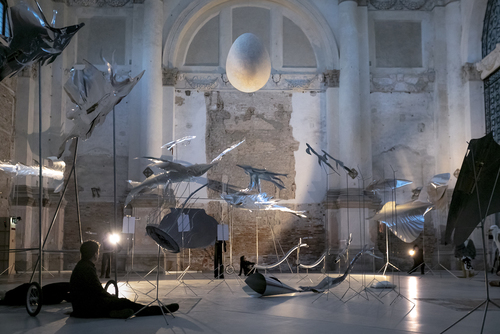Art is a verb: Radical imagination for oceanic futures
Art
By Francesca Thyssen-Bornemisza
Art is a verb.
Art, in its truest form, is not static. Like the sea, it is never still. It moves, responds, and provokes; it invites us to see differently, to feel more deeply, and, most importantly, to imagine alternative ways of coexisting in a fractured world.
When I founded TBA21 Thyssen-Bornemisza Art Contemporary more than twenty years ago, it was with the conviction that art is not only about collecting, but about manifesting change. Art is a powerful instrument of hope and vision. Working closely with artists, I have witnessed how precise and expansive their research can be — how they draw knowledge from multiple disciplines, as rivers flow into the sea, and weave new narratives that move beyond the rigid silos of conventional expertise.
Today, as we confront ecological collapse, the erosion of democratic values, and profound social fragmentation, the role of artists as visionaries, as truth-tellers, and as stewards of imagination has never been more vital.
The Foundation has three important homes. In Madrid, at the Thyssen-Bornemisza National Museum, we hold the heart of our collection and foundation. In Jamaica, the Alligator Head Foundation safeguards one of the country’s largest conservation sites, with a thriving marine laboratory and community-led restoration projects. And in Venice, Ocean Space inhabits the restored Church of San Lorenzo, dedicated entirely to the ocean.
Venice was a natural choice. It is a city that has always lived in dialogue with the sea. While the Biennale gathers national pavilions under separate flags, the ocean connects us all, beyond borders or interests. Ocean Space was created to embody that idea: a civic space for the ocean as a living entity, a home for imagination, science, and collective responsibility.
San Lorenzo was not restored to become another museum, but to serve as a meeting ground. Here, artists, scientists, policymakers, and communities come together to think and act differently about the sea. Each exhibition is part of a wider commitment: to foster ocean literacy, to amplify voices too often unheard, and to nurture new ethics of care. Our forthcoming program, including the 2026 exhibition RE/Atriate & New Originals, curated by Khadija von Zinnenburg Carroll, will broaden discourse on repatriation, decolonization, and the ocean as a bearer of ancestral wisdom. Commissions by the REPATRIATES Collective and Verena Melgarejo Weidant will further deepen the understanding of oceanic kinship, storytelling, and Indigenous perspectives.
In Jamaica, the Alligator Head Foundation has become the country’s largest marine laboratory and a hub for regeneration. Local communities lead coral reef restoration, we have released over 20,000 turtle hatchlings into the wild, and we have seen a 200% increase in fish biomass, with species once thought gone returning. Our research into resilient coral has received international recognition, but its truest impact lies in restoring balance to the sea. On the global stage, TBA21 holds a unique role as the only art organization with observer status at the International Seabed Authority, ensuring that creativity and ethics inform decisions about the deep sea. At the UN Ocean Conference and other international fora, we advocate for art not as ornament, but as infrastructure for change.
My connection to the ocean is deeply personal. Growing up between Switzerland and Jamaica, I learned to snorkel as a child and fell in love with the reefs. Over time, I watched them collapse — the corals bleach, the fish vanish, the balance unravel. Those memories remain with me and drive my commitment today. Ocean Space, and all of TBA21’s work, is my way of giving back — of creating places where we do not just talk about the ocean, but listen to it, and speak for it.
This journey has never been mine alone. From the beginning, TBA21 has been built on enduring relationships with artists, researchers, activists, and communities who share a profound sense of responsibility. It has been a privilege to walk alongside extraordinary voices such as Olafur Eliasson, Joan Jonas, Tabita Rezaire, Taloi Havini, Claudia Comte, Ernesto Neto, and many others, whose imagination constantly expands the boundaries of what art can achieve.
For me, art has never been about aesthetics alone. It has always been about ethics: moving from domination to interdependence, from extraction to regeneration, from the illusion of control to the humility of listening. What we are shaping together is not only a cultural practice, but a civic one — rooted in solidarity, and in a radical imagination that resists surrender to the status quo.
To say that art is a verb is to believe in its ability to move us — as tides move shorelines — into awareness, into empathy, and into action. In this time of planetary crisis, such movement is no longer optional. It is a moral imperative.
Portrait © Francis Tsang
View of the performance "Ocean Space" by artists Petrit Halilaj and Alvaro Urbano © Gerdastudio
